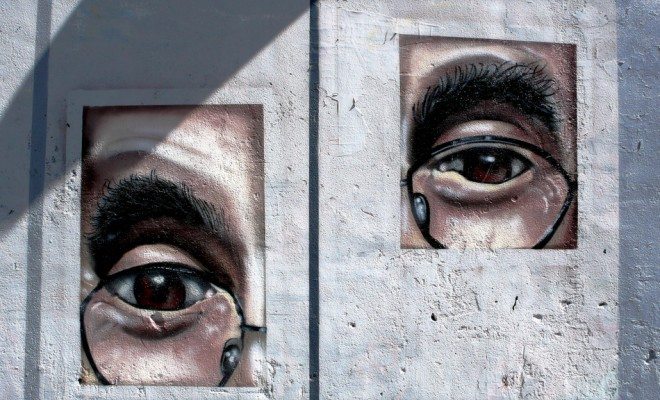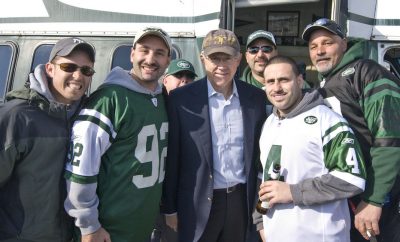
Society and Culture
‘City as Art’ Exhibition Brings Massive Graffiti Collection to the Public for First Time
“It’s in the nature of graffiti that it can’t be contained by any established institution, commercial or educational. As a site-specific art form, it dies when separated from the where and when of its creation. Also, its energy comes from the artist’s self-identification as an aesthetic and social outlaw.“
-Ken Johnson, New York Times
Martin Wong came to New York City in 1978 as an openly gay painter and sculptor from San Francisco. He settled in the Lower East Side of Manhattan, Loisadia, full of home artist communities like the Nuyorican Poets Café. Along with the South Bronx this was an epicenter street graffiti in New York during the late 1970s and 1980s. As an outsider from the West Coast, Wong was immediately spellbound by the radiant graffiti around him, passionately seeking out graffiti writers and their art around the city. In 1982, Wong began working at Pearl Paint, an art supply store on Canal Street, and would trade art supplies with graffiti writers in return for graffiti sketchbooks, drawings, and paintings. Through the 1980s, Wong amassed a colossal collection of graffiti art of 300 objects — including 50 sketchbooks, more than 100 canvases, and more than 150 works on paper. Artists range from the well-known art stars such as Jean-Michel Basquiat and Keith Haring to graffiti writers such as Christopher “DAZE” Ellis, FUTURA 2000, LAII, LADY PINK, and Lee Quiñones.
In all, Wong’s collection of graffiti art is, perhaps, the largest of its kind. Wong “wanted to become the Albert Barnes of graffiti,” recalled Ellis, referring to the famous collection of Post-Impressionist and early Modern works amassed by the chemist. He was “interested in far more than collecting the artists’ works, since he became a mentor to several of them,” Sean Corcoran, the curator of prints and photographs at the Museum of the City of New York, told Art in America. “He often traded with them, sometimes selling one of his own paintings and turning around and spending all the money buying work from graffiti artists.” For a short time, Wong even operated a museum of graffiti art in a row house on Bond Street until rising real estate values forced the venue to close. When Wong was diagnosed with AIDS in 1994, he donated his entire collection to the Museum of the City of New York before he died on October 12, 1999 at the age of 53. “He could have sold off the collection piecemeal, and there were interested European buyers,” said Corcoran. “[B]ut he felt strongly that the collection should remain in New York, and he donated it wholesale to the Museum.”
Curated by Cocoran, “City as Canvas” at the Museum of the City of New York is the first exhibition of Martin Wong’s graffiti art. “The collection was never able to be seen,” said Charlie Ahearn, an early graffiti aficionado and director of the movie Wild Style. Viewers can see a wide array of artifacts from sketchbooks to graffiti painted on canvas, as well as photographs that documented the New York graffiti movement during the ’70s and ’80s. Yet underneath this vast presentation — and the pieces, especially the photographs, are stunning — lurks an unsettling suspicion. Does graffiti belong on a canvas, or in a museum?
“Graffiti is really defined as some one who writes their name in an illegal fashion on public property,” Ahearn mused before “City as Canvas” opened. During the ’70s and ’80s graffiti was a “direct response to the crumbling city,” according to urban historian L.E. Neal. For graffiti writers, tagging was political; it was an “act of defiance.” Graffiti was an act of appropriation, making the city one’s own by claiming the space, says RxArt. Amid the destruction of communities, and the failure of the government to protect working-class communities in urban crisis, the graffiti movement was a “fight for space.” Removed from the street, the graffiti aesthetic on canvas is devoid of political meaning, it is an inauthentic representation of street politics, though it might present sentimental value to viewers who can remember New York City during that time.
One canvas graffiti piece illustrates this point for the entire collection. Lee Quiñones’ “Howard the Duck” (1988) is an oil on canvas reproduction of a street mural, originally produced in the early 1980s. It depicts a cartoon duck, in suit and tie, shielding himself with a garbage lid from Lee’s tag emblazoned on a brick wall. Above the scene a message reads in graffiti script: “Graffiti is art and if art is a crime, let go forgive all.” While the colors are vivid, and the message provoking, the piece would have been more poignant, and interesting if it was presented as graffiti mural on the street, as originally intended. On canvas, however, the piece is unengaging. “[T]oday that work doesn’t interest me aesthetically in the same way it might have interested writers or just art fans back in the early 1980s” said R.J. Rushmore, a young contemporary graffiti artist, and editor-in-chief of Vandalog. Initially, Ahearn considered it a mistake for Wong to bequeath his collection to any institution, but now values the exhibition at MCNY because “it places the emphasis on the historical picture of [graffiti], rather than the art world context.”
Photography is, perhaps, an appropriate method of presenting graffiti because it captures its urban context. The New York graffiti subculture was an insular world during the 1970s; the writers depended on their anonymity to continue their work while police crackdowns intensified. As a result, the graffiti writers let few outsiders into their lives, among those were photographers Henry Chalfant, Martha Cooper, Jon Naar, and Ahearn, a cinematographer. “City as Canvas” presents a section of their photographs that candidly capture the graffiti subculture with raw passion. One photo, taken by Naar, depicts a gang of writers in a graffiti-festooned subway entrance, proudly holding papers marked with their respective tags. An iconic Cooper photograph dramatically portrays a graffiti writer at work straddling the gap between two subway trains, one foot on either train. These photos, along with the sketchbooks, in my mind, are the real gems in “City as Canvas.”
“I think we’re in the right window to look at what these kids were doing and [the] effects on culture,” said Corcoran. “For us, this show is partly about how graffiti originated in New York and became a global phenomenon…Thanks to photographers like Martha Cooper and filmmakers like Charlie Ahearn, it was disseminated worldwide. The materials in the show say a lot about what New York looked like in the 1970s and 80s.”
“It’s all over the world,” Corcoran told the New York Times, ”You have kids in Europe painting trains because of what they saw in ‘Wild Style.’” Moreover, “City as Canvas” holds particular relevance today; after Banksy’s month-long “residency,” the destruction of 5 Pointz and the subsequent surge in illicit graffiti over the course of the last six months, graffiti is once again a poignant and divisive issue in New York.
“City as Canvas: Graffiti Art from the Martin Wong Collection” is on view through September 1, 2014 at the Museum of the City of New York, 1220 Fifth Avenue New York, NY, 10029.
—
Ryan D. Purcell (@RyanDPurcell) holds an MA in American History from Rutgers University where he explored the intersection between hip hop graffiti writers and art collectives on the Lower East Side. His research is based on experience working with the Newark Public Arts Project and from tagging independently throughout New Jersey and New York.
Feature image courtesy of [Igal Malis via Flickr]









Comments